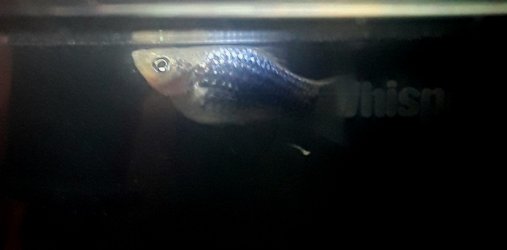To be fair to the person who served you at the shop, young male livebearers have an anal fin that looks like a female's anal fin until they mature. So if you got a young male, then it would be more difficult to tell the true sex of that fish.
--------------------------
As for male/ female ratios. With livebearers you want at least 4 females per male, and preferably more. The best way to keep most livebearers (but not swordtails) is in separate tanks for males and females. This allows the females to produce babies without being hassled by males who are constantly trying to breed with them. Then every month or so you add a male to the tank and they can do their thing, then after a week the male can be removed and put back in his own tank leaving the females to carry on being mums

With Swordtails, a dominant female can change sex and become a male if there are no male fish in the tank for several months. For these guys you try to have 1 male present most of the time, or if you have a female only tank, then put a male in there every couple of weeks, and leave him there for a few days before moving him out.
Make sure you have lots of floating plants in the tank for the females to hide in when giving birth, and for the baby fish to hide in. The best plant for livebearers is Water Sprite (Ceratopteris thalictroides). It normally floats on the surface but can also be planted in the substrate where it grows into a lovely bright green shrub shaped plant.
If you don't have live plants then plastic plants can be left to float around the surface and they will help.
Do not move pregnant female livebearers into small breeding traps/ nets. It stresses them out and they can go into labour before they are meant to and you get premature babies that die.
--------------------------
Your pH is probably a bit low for Mollies and I'm guessing you GH will be too. So don't get any more Mollies

--------------------------
Update on my blue wag, after heading to get my water tested, they also mentioned upping my ph, but did tell me our water here generally has a ph of 7 or a little over. So, got back and did a roughly 50% water change without the tabs. Tested and ph was smack on 7! Fantastic, right? Wrong!! Blue wag swam directly to the top after the tank was refilled and nosedived to the bottom...and RIP blue wag!
What are the tabs you mention here?
Did you use a water conditioner/ dechlorinator on the new water before it was added to the tank?
--------------------------
Most livebearers are genetically weak these days (and for the last 20 years) due to inbreeding. They are so bad that the breeders have been collecting wild caught fish of the same species (and different species to hybridise) just to add new bloodlines and to help make the fish a bit stronger. Guppies are a classic example where they have cross bred them with Endler's Livebearer to stop all the babies being born with deformities and to stop the fish from dropping dead when you look at them the wrong way, (slight over exaggeration about dropping dead when you look at them but they are genetically weak).
Livebearers are also heavily stocked in shop tanks due to their high demand by customers. This means the water quality in that tank is more likely to be less than optimal and the fish are going to be more stressed.
--------------------------
Tetras, barbs, rasboras and Corydoras occur in groups of hundreds or even thousands of individuals, and some of their marine counterparts occur is schools of millions. In an aquarium they need to be kept in groups of 10 or more.
Livebearers are a fish that live in small schools or groups consisting of 20-50 individuals of their own kind. If there are not enough fish in their group they will sometimes hang out with other species of fish that are a similar size and shape to them. In good conditions, or when waterways shrink, these groups can come together to form larger schools.
Male Livebearers tend to have loosely defined territories frequented by females. Sometimes there will be a number of males (bachelor groups) in the same territory. The males will chase other males away so they can breed with all the females. The females freely move around waterways in search of food and safe areas to give birth. Males will follow the females but are usually driven away by other males when they enter a bigger male's territory.
Female livebearers control the group and use the males for reproductive purposes only












